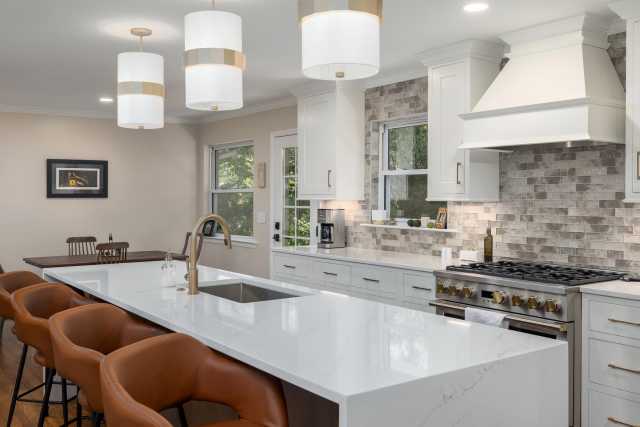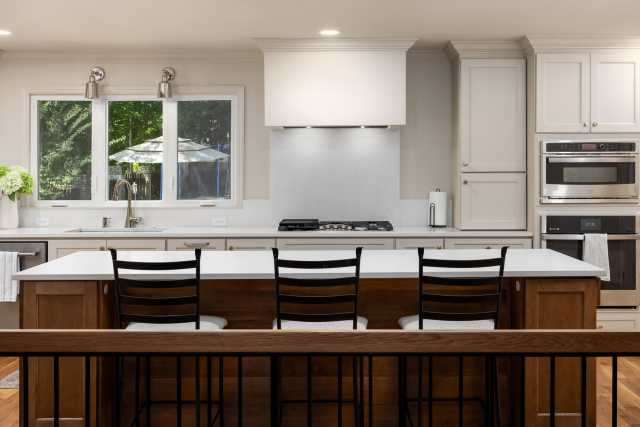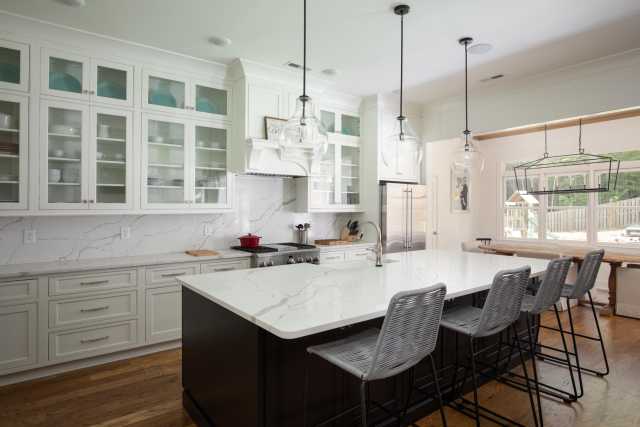The Culinary Stage: A Comprehensive Guide to Designing the Perfect Residential Chef's Kitchen - Part 5

Setting the Scene - Mastering Ambiance, Lighting, and Personalization
A perfectly functional kitchen can still fail if it is not a pleasant place to be. The final layer of design transforms the high-performance workshop into an inviting and inspiring environment. This is achieved through a sophisticated lighting scheme, thoughtful accommodation of social dynamics, and the infusion of personal style.
The Art of Illumination: A Layered Approach to Kitchen Lighting
Lighting is one of the most critical elements in kitchen design, directly impacting both safety and ambiance. �A single, central ceiling fixture is wholly inadequate for a chef's kitchen. The professional standard is a
- layered lighting strategy, which combines three distinct types of illumination to create a space that is both highly functional and beautifully atmospheric. Ambient Lighting: This is the foundational, general light that fills the entire room. It ensures safe navigation and provides a base level of brightness. This layer is typically achieved with recessed can lights strategically placed over pathways, or with decorative flush-mount or semi-flush ceiling fixtures.
- Task Lighting: This is the most important layer for the cook. Task lighting provides bright, focused, shadow-free illumination directly onto all work surfaces. The most essential application is under-cabinet lighting, which illuminates the countertops for all prep work. Additional task lighting includes pendant lights hung over the kitchen island and sink, and dedicated lights within the range hood to illuminate the cooktop.
- Accent (or Decorative) Lighting: This final layer adds depth, drama, and personality. It is used to highlight architectural details, artwork, or beautiful objects. Examples include LED strip lighting inside glass-front cabinets to showcase dishware, toe-kick lighting that gives base cabinets a floating effect, and a stunning statement chandelier or a series of pendants over an island or dining area that serve as a visual centerpiece.
To make this system truly versatile, all lighting layers should be on separate circuits and controlled by dimmers. �This allows the user to transform the room's mood instantly—from bright, full-on task mode for cooking to a soft, ambient glow for dining and socializing. For task areas, a 'cool white' light with a color temperature around 4000K-5000K is recommended, as it renders the colors of food most accurately.
�Under-Cabinet Lighting: A Deep Dive into Optimal Placement
Given its importance, the placement of under-cabinet lighting deserves special attention. A common mistake is to install the lights at the back of the cabinet, against the wall. Expert and user consensus overwhelmingly recommends placing fixtures toward the front of the upper cabinets, just behind the front lip or frame.The reasoning for this forward placement is threefold. First, it directs the light onto the center of the countertop, which is the primary work area. Second, it prevents the cook's own body from casting a shadow over their hands while they work. Third, it avoids creating harsh grazing light across the backsplash, which can highlight minor imperfections in tile or grout work and create distracting glare.�Before final installation, it is always wise to temporarily tape an LED strip in place to test the effect, especially if you have a highly polished or reflective countertop, to ensure there is no direct, annoying glare from your typical working position.
The Social & Adaptable Kitchen
The modern chef's kitchen is rarely a solitary space; it is the bustling hub of the home, a magnet for family and friends.�The design should embrace and facilitate this social role. Open-plan layouts that flow into living and dining areas are ideal. Kitchen islands with dedicated seating are crucial for allowing guests to be part of the action without getting in the way of the cook.For larger spaces, creating distinct "guest zones" within or adjacent to the kitchen can enhance comfort. This could be a small seating area with a pair of comfortable armchairs for a cozy reading nook, or a dedicated beverage station where guests can help themselves without interrupting the cooking workflow.�This concept of adaptability extends to the household's other needs. A well-designed kitchen plan will consider how tasks like laundry, pet feeding, or even homework can be integrated into the greater kitchen ecosystem without causing conflict or clutter.
Beyond Stainless Steel: Infusing Personal Style and Warmth
While a chef's kitchen is rooted in function, the perfect kitchen must also be a reflection of its owner's personality and a space that "sparks joy". �After the functional bones are in place, the final step is to layer in personal touches that bring warmth and character. This can be achieved in countless ways:
- Color: Use a bold color on the cabinetry, the island, or a feature wall backsplash to make a statement.
- Materials: Introduce warmth and texture with materials beyond stainless steel. Copper or brass hardware and fixtures can add a touch of luxury. A rustic wood element, like open shelving or a butcher block counter, can soften an industrial aesthetic.
- Decor: There is always room for art and personal objects. Hang a favorite painting, display a collection of pottery, or incorporate unique, thrifted decor to add charm and a sense of history.
- Life: Adding plants and fresh herbs not only brings life and color into the space but also provides fresh ingredients at arm's reach.
Synthesizing the Elements into Your Culinary Masterpiece
The journey to designing the perfect residential chef's kitchen is a deeply personal and highly technical endeavor. It begins not with a catalog of appliances, but with a clear understanding of one's own culinary ambitions and lifestyle. The core principles derived from professional kitchens—a relentless focus on function, an ergonomic workflow organized by zones, and the use of high-performance, durable materials—provide the foundational grammar for the design.
Success lies in the intelligent synthesis of these principles. It is in layering the modern concept of work zones over the time-tested efficiency of the work triangle. It is in selecting powerful, professional-grade appliances and supporting them with the necessary, and often unseen, infrastructure of ventilation and power. It is in engineering storage that prioritizes immediate accessibility over sheer volume, through the strategic use of deep drawers, pull-outs, and intelligent organizers. It is in choosing surfaces that balance industrial-strength durability with residential comfort and style. And finally, it is in casting the entire stage with a sophisticated, layered lighting scheme that can shift the room's mood from a bright, focused workshop to a warm, inviting social space.
Ultimately, the "perfect" kitchen is one that feels like a natural extension of the cook who inhabits it. It is a space that empowers creativity, fosters connection, and makes the act of preparing a meal an experience of pure joy and effortless flow. By arming oneself with a clear personal vision and the detailed knowledge outlined in this guide, the passionate home cook can effectively collaborate with designers and builders to bring their culinary masterpiece to life.





